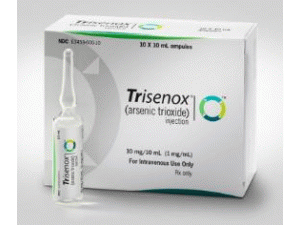三氧化二砷,三氧化二砷注射剂(TRISENOX 1mg/ml 10mlx10)
 药店国别:无
产地国家:英国
处方药:是
所属类别: 1毫克/毫升 10安瓿x10毫升
包装规格: 1毫克/毫升 10安瓿x10毫升
计价单位:盒
生产厂家中文参考译名:无
生产厂家英文名:Teva
原产地英文商品名:TRISENOX 1mg/ml 10mlx10Arsenic
原产地英文药品名:Arsenic Trioxide
中文参考商品译名:萃克森注射液 1毫克/毫升 10安瓿x10毫升
中文参考药品译名:三氧化二砷
曾用名:无
药店国别:无
产地国家:英国
处方药:是
所属类别: 1毫克/毫升 10安瓿x10毫升
包装规格: 1毫克/毫升 10安瓿x10毫升
计价单位:盒
生产厂家中文参考译名:无
生产厂家英文名:Teva
原产地英文商品名:TRISENOX 1mg/ml 10mlx10Arsenic
原产地英文药品名:Arsenic Trioxide
中文参考商品译名:萃克森注射液 1毫克/毫升 10安瓿x10毫升
中文参考药品译名:三氧化二砷
曾用名:无
简介
部份中文三氧化二砷处方资料(仅供参考) 通用名称:注射用三氧化二砷 英文名称:Arsenic Trioxide for Injection 汉语拼音:Zhusheyong Sanyanghua’ershen 本品主要成份化学名称:三氧化二砷 性 状:本品为白色疏松块状物或粉末. 适 应 症:本品适用于急性早幼粒细胞白血病,原发性肝癌晚期。 用法用量 1、治疗白血病的用法用量成人每日一次,每次5~10mg(或按体表面积每次7mg/m2),用5%葡萄糖注射液或0.9%的氧化钠注射液500ml溶解稀释后静脉滴注3~4小时。四周为一疗程,间歇1~2周,也可连续用药。勿将本品与其它药物混合使用。注射后勿存留残余本品以后继续使用。儿童每次0.16mg/kg,用法同上。 2、治疗肝癌的用法用量:每日一次给药,每次7-8mg/m2,用5%葡萄糖注射液或0.9%氯化钠注射液500ml溶解稀释后静脉滴注3-4小时。两周为一疗程,间歇1至2周可进行下一疗程。 不良反应 本品的不良反应与患者个体对砷化物的解毒和排泄功能以及对砷的敏感性有关,出现的不良反应有: 1、白细胞过多综合征:在As2O3缓解APL的过程中,部分患者出现外周备白细胞增多(为异常中幼粒细胞)此时可出现类似维甲酸综合征的表现。因白细胞过多引起DIC加重或加重DIC、纤溶亢进、脑血管栓塞引起脑出血、肺血管栓塞导致呼吸窘迫综合征、浸润症状加重,如出现视力下降、骨关节疼痛及尿酸肾病。 2、体液潴留:患者治疗时出现体重增加、胸膜渗出、心包渗出及颜面浮肿等。 3、消化系统:恶心、呕吐、厌食、腹痛、腹泻等为常见的不良反应,对症处理,停药后可消失。一部分患者可出现肝脏损害,包括转氨酶升高、黄疸,停药后肝功能可恢复正常。在巩固治疗的患者肝功能变化是温和的。 4、泌尿系统:急性肾功能衰竭较少见,可出现肾功能变化,一般停药后可恢复。 5、神经系统损害:在用药后10~20后左右出现多发性神经炎和多发性神经根炎症状。患者有四肢疼痛、麻木,感觉由过敏或异常发展到痛、温、触觉的迟钝、消失,甚至感觉性共济失调。同时,有肢体无力、远端肌肉萎缩,可有明显的自主神经障碍。砷中毒性周围神经炎与一般周围神经炎无区别。大约34%患者于用药的早期出现程度不等的一过性脑血管痉挛性头通。 6、心血管系统:可出现心悸、胸闷、心电图变化,包括窦性心动过速,ST段下移,T波倒置或低平,PR间期延长或完全性房室传导阻滞,但多为可逆的;QT间期延长及在此基础上的室性心率失常已有多次报道。 7、皮肤干燥、红斑或色素沉着。 禁 忌:严重的肝、肾功能损害者、孕妇及长期接触砷或有砷中毒者禁用。 注意事项 1、 本品为医疗用毒性药物,必须在专科医生指导下使用。 2、 在用本品治疗前,需对患者进行12-导联(12-lead)的心电图检查、血清内电解质(钾、钙、镁)和肌酐的检查。纠正已存正的电解质异常。患者体内的电解质、血液及血凝数据至少每周检查2次,心电图(ECG)记录至少每周1次。心电图严重异常者(包括QT间期延长者、具有潜在致命性的尖端扭转型室友性心动过速和APL分化综合征)慎用本品。 3、 使用本品期间,不宜同时使用能延长QT间期的药物(一些抗心律失常药,硫利达嗪)或导致电解质异常的药物(利尿剂或两性霉素B)。 4、 用药期间出现外周血白细胞过高时,可酌情选用白细胞单采分离,或应用羟基脲、高三尖杉酯碱、阿糖胞苷等化疗药物。 5、使用过程中如出现肝、肾功能异常,应及时做针对治疗,密切观察病情,必要时停药。 6、如出现其他不良反应时,可对症治疗,严重时可停药观察。 7、遇未按规定用法用量用药而发生急性中毒者,可用二巯基丙醇等药物解救。 孕妇及哺乳期妇女用药:孕妇禁用,哺乳期妇女用药时则不宜哺乳。 儿童用药:未发现儿童用药引起异常情况的报道,但建议儿童不宜将本品作首选药物治疗。 老年患者用药:未发现老年患者使用本品引发异常情况的报道。 药物相互作用 在本品的使用过程中,避免使用含硒药物及食用含硒食品。 使用本品期间,不宜同时使用能延长QT间期的药物(一些抗心律失常药,硫利达嗪)或导致电解质异常的药物(利尿剂或两性霉素B)。 药物过量: 如使用本品过量引起急性中毒者,可用二巯基丙醇抢救。药理毒理急性早幼粒细胞白血病(APL)是急性髓性白血病的一种亚型,其重要的细胞遗传学特征是t(15;17)染色体易位,累及15号染色体上早幼粒细胞性白血病基因(PML)和17号染色体上的维甲酸受体基因(RARα),产生异常的PML-RARα 融合基因,表达癌蛋白PML-RARα ,已知PML-RARα既能阻断细胞分化,又能抑制凋亡。 因此,t(15;17)染色体易位产生异常的PML-RARα融合基因可能是APL发病的主要机制之一。体外研究表明As2O3能够正常诱导NB4细胞株(一种具有典型APL特征的细胞株)和对全反式维甲酸耐药的APL细胞株发生凋亡。 实验显示As2O3这种作用是通过降解PML/RARα 蛋白以及在mRNA和蛋白质水平上下调抑制基因BCL-2的表达而实现的。As2O3与全反式维甲酸(ATRA)和其它化疗药物无交叉耐药现象,As2O3对ATRA耐药细胞(AR-2,NBR-1及NB4-360)仍有诱导凋亡作用;对于无论有或者无PML-RARα异常的多种肿瘤细胞系也均有抑制生长及诱导凋亡作用,这表明As2O3肿瘤的作用并不依赖维甲酸的调节途径。 目前研究表明,As2O3可能是通过干扰巯基酶的活性,调控癌相关基因的表达以及阻碍细胞周期的进程等途径,发挥其抗癌的生物学效应。 动物毒性试验结果表明:比格犬以0.1,0.3,3.0mg/kg连续静脉注射给药30天,低、中剂量组动物在给药末期出现心率下降;高剂量组动物细胞和血红蛋白均显著降低,停药时进行病理组织学检查见该动物多数出现肝细胞变性、少数发生肝细胞坏死,肾小球囊内可见嗜酸性细胞和炎性细胞浸润及坏死细胞;睾丸中大部分曲细精管细胞层次减少,精子生成受抑制。 贮 藏:密闭保存 有 效 期:12个月。 英文版说明 TRISENOX 1mg/ml 10ml x10Arsenic Trioxide1. Name of the medicinal productTRISENOX 1mg/ml concentrate for solution for infusion2. Qualitative and quantitative compositionOne ml of TRISENOX contains 1 mg of arsenic trioxideFor the full list of excipients, see section 6.13. Pharmaceutical formConcentrate for solution for infusionSterile, clear, colourless, aqueous solution.4. Clinical particulars4.1 Therapeutic indicationsTRISENOX is indicated for induction of remission, and consolidation in adult patients with:• Newly diagnosed low-to-intermediate risk acute promyelocytic leukaemia (APL) (white blood cell count, ≤ 10 x 103/µl) in combination with all-trans-retinoic acid (ATRA)• Relapsed/refractory acute promyelocytic leukaemia (APL)(Previous treatment should have included a retinoid and chemotherapy)characterised by the presence of the t(15;17) translocation and/or the presence of the Pro-Myelocytic Leukaemia/Retinoic-Acid-Receptor-alpha (PML/RAR-alpha) gene.The response rate of other acute myelogenous leukaemia subtypes to arsenic trioxide has not been examined.4.2 Posology and method of administrationTRISENOX must be administered under the supervision of a physician who is experienced in the management of acute leukaemias, and the special monitoring procedures described in section 4.4 must be followed.PosologyThe same dose is recommended for adults and elderly.Newly diagnosed low-to-intermediate risk acute promyelocytic leukaemia (APL)Induction treatment scheduleTRISENOX must be administered intravenously at a dose of 0.15 mg/kg/day, given daily until complete remission is achieved. If complete remission has not occurred by day 60, dosing must be discontinued.Consolidation scheduleTRISENOX must be administered intravenously at a dose of 0.15 mg/kg/day, 5 days per week. Treatment should be continued for 4 weeks on and 4 weeks off, for a total of 4 cycles.Relapsed/refractory acute promyelocytic leukaemia (APL)Induction treatment scheduleTRISENOX must be administered intravenously at a fixed dose of 0.15 mg/kg/day given daily until complete remission is achieved (less than 5% blasts present in cellular bone marrow with no evidence of leukaemic cells). If complete remission has not occurred by day 50, dosing must be discontinued.Consolidation scheduleConsolidation treatment must begin 3 to 4 weeks after completion of induction therapy. TRISENOX is to be administered intravenously at a dose of 0.15 mg/kg/day for 25 doses given 5 days per week, followed by 2 days interruption, repeated for 5 weeks.Dose delay, modification and reinitiationTreatment with TRISENOX must be temporarily interrupted before the scheduled end of therapy at any time that a toxicity grade 3 or greater on the National Cancer Institute Common Toxicity Criteria is observed and judged to be possibly related to TRISENOX treatment. Patients who experience such reactions that are considered TRISENOX related must resume treatment only after resolution of the toxic event or after recovery to baseline status of the abnormality that prompted the interruption. In such cases, treatment must resume at 50% of the preceding daily dose. If the toxic event does not recur within 7 days of restarting treatment at the reduced dose, the daily dose can be escalated back to 100% of the original dose. Patients who experience a recurrence of toxicity must be removed from treatment.For ECG, electrolytes abnormalities and hepatotoxicity see section 4.4.Special populationsPatients with hepatic impairmentSince no data are available across all hepatic impairment groups and hepatotoxic effects may occur during the treatment with TRISENOX, caution is advised in the use of TRISENOX in patients with hepatic impairment (see section 4.4 and 4.8).Patients with renal impairmentSince no data are available across all renal impairment groups, caution is advised in the use of TRISENOX in patients with renal impairment.Paediatric populationThe safety and efficacy of TRISENOX in children aged up to 17 years has not been established. Currently available data for children aged 5 to 16 years are described in section 5.1 but no recommendation on a posology can be made. No data are available for children under 5 years.Method of administrationTRISENOX must be administered intravenously over 1-2 hours. The infusion duration may be extended up to 4 hours if vasomotor reactions are observed. A central venous catheter is not required. Patients must be hospitalised at the beginning of treatment due to symptoms of disease and to ensure adequate monitoring.用药温馨提示:当您服用此药物时,需定期接受医疗专业人士的检查,以便随时针对其药效、副作用等情况进行监测。本网站所包含的信息旨在为患者提供帮助,不能代替医学建议和治疗。
药品价格查询,专业药品查询网站,药品说明书查询,药品比价 » 三氧化二砷,三氧化二砷注射剂(TRISENOX 1mg/ml 10mlx10)
药品价格查询,专业药品查询网站,药品说明书查询,药品比价 » 三氧化二砷,三氧化二砷注射剂(TRISENOX 1mg/ml 10mlx10)


